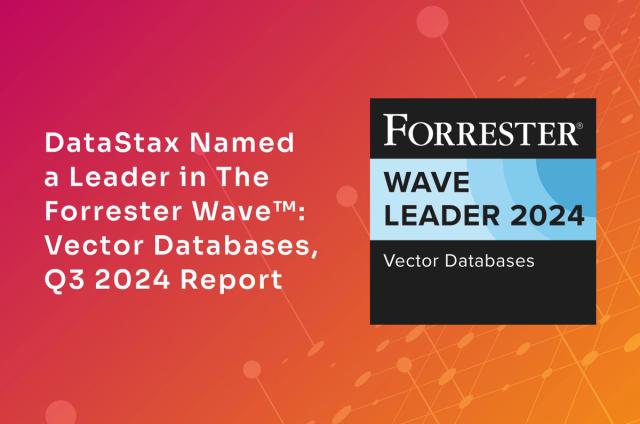The Ghosts of Customers Past, Present, and Future

Charles Dickens wrote his famous novel, A Christmas Carol, 176 years ago this year. Central to the story is Ebenezer Scrooge, a miserly figure resistant to change and largely closed off to the rest of the world.
During the story, Scrooge is visited by his former business partner and the three spirits: the Ghosts of Christmas Past, Present, and Future.
The Ghost of Christmas Past takes Scrooge on a journey backward to a simpler time. However, it is here that the seeds of Scrooge’s present day unhappiness first started growing, and the spirit begins to foretell Scrooge’s future.
The Ghost of Christmas Present takes Scrooge on a trip showing him scenes of seasonal festivity. This is in stark contrast to Scrooge himself and is generally intended to demonstrate how his social debt, isolation, and disregard for others has led him to a life of loneliness.
The third and final spirit that visits Scrooge, The Ghost of Christmas Future, shows him his ultimate demise, which shakes and rattles him.
Scrooge begs for another chance to change, and he wakes up on Christmas Day a changed man—and a man with a second chance.
A Christmas Carol is a story of transformation and of second chances.
In the real world of technology that we live and breath every day, the former is an omnipresent reality that must be embraced while the latter often a luxury only afforded only in allegories like the above.
Phrased another way, second chances are not guaranteed. Only those companies that can successfully navigate the tension between legacy technical debt and an increasingly evolving consumer will thrive.
In this blog, we’ll take a quick look backwards with a particular focus on the changing consumer as a key driver to change and innovation in a consumption-based economy. Then we’ll explore some of the current disruptive factors that are driving companies toward transformation. Along the way, we’ll draw out some themes as a means to portend the future.
Ghost of Consumer Past: Pre-Internet Ubiquity
Let’s rewind back to the mid-to-late 90s. Bill Clinton was president and cutting-edge consumer technology meant an Intel Pentium III desktop computer dialing up to the “World Wide Web” on a 28.8k or 56k modem.
 The most popular phone of the time was a Nokia 3310.
The most popular phone of the time was a Nokia 3310.
Internet usage was still nascent at only 4.1% of the global populace, and the idea of entering a credit card online to purchase anything was still foreign to many.
The consumer journey that had existed for decades was well understood, linear, and highly predictable. This was a huge benefit as the backend systems that supported the journey were largely well-understood and fixed as well.
Preparing for the holiday season was often a matter of scaling up resources to meet the estimated demand of the business based on years of data.
This world looked something like this:
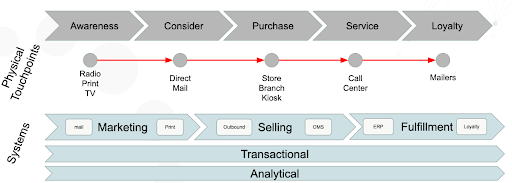
Attributes of Consumer Past
- Linear and predictable
- Geographically limited and local
- Relatively static for decades with little innovation
- Customer experience controlled and driven by the retailer (inside and out)
- Customer journey well-understood
- Business functions largely siloed, but effective
- KPIs along the value chain well-established and trackable
- HIPPO’s (Highest Paid Person’s Opinion) often made decisions on “feeling” or “gut” due to lack of data
The underlying databases supporting these systems were relational, housed in expensive-to-operate data centers, and often only loosely integrated if at all.
Many traditional brick-and-mortar companies were cautious about getting into e-commerce and largely treated it as an experiment “just in case” this internet thing really took off. Even though companies were willing to make initial investments in e-commerce, most took an extremely cautious approach in order to not risk their core business, which was still brick-and-mortar (e.g., Borders).
Oftentimes, this meant standing up independent technology stacks for marketing, selling, and fulfillment systems.
This resulted in physical and digital consumer experiences that were decoupled from one another. The customer journey was becoming more complex. But it was still manageable.
In-store was in-store and the web was the web.
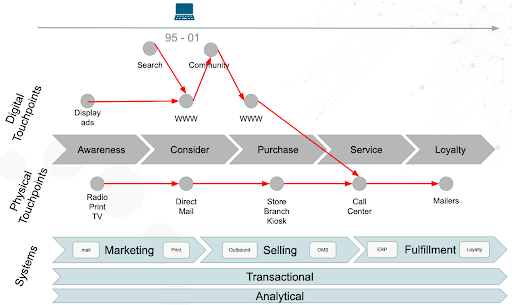
Meanwhile, the digital natives unshackled from decades of technical debt began embracing emerging open source and cloud technologies to innovate at a breakneck pace compared to brick-and-mortar counterparts. More on this later.
Then two technologies converged that would change everything.
The first was the iPhone. The second was vastly improved mobile connectivity with 2G and then 3G.
Now, consumers were continually tethered to the internet and, along with it, were increasingly opening their wallets to online shopping at an increasing rate.
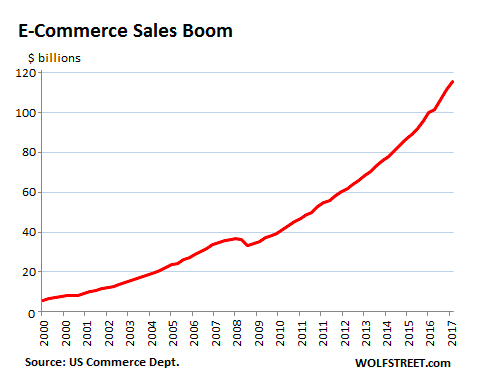
Ghost of Consumer Present
Today, we live in an always-connected, highly mobile world with a generation (Gen Z) that doesn’t know a day without high-speed internet entering into the economy. Practically anything desired can be delivered that same day by asking an IoT smart device.
This generation is producing more data than ever before. And they’re willing to give up more of that data in a fair exchange for highly personalized and convenient services and experiences.
Brands that nail this “fair exchange” will be rewarded with consumers that are more loyal and spend more on average than brands that cannot engage with the right message on the right channel at the right time. For example, one Harvard Business Review study found that omnichannel customers make 23% more repeat-shopping trips than their counterparts.
The consumer is at the center of everything. While brands can influence a customer journey, the reality is that consumers will engage on their channels of choice. In other words, the customer journey is now meandering and highly contextual.

Attributes of Consumer Present:
 Consumer is at the center and driving their experience
Consumer is at the center and driving their experience- Customer journey is nonlinear and unpredictable, and there are no longer a few customer journeys, but hundreds of them
- Massive volumes of globally distributed managed and unmanaged customer-generated data
- Pace of change is not only increasing but accelerating (new digital channels are popping up)
- Monolithic business functions are breaking down due to a lack of agility
- Traditional KPIs aren’t good enough and there are more of them
- HIPPOs in decline; data-driven decisions will win
- Consumer expectations are at an all-time high; they expect that a brand engages in a highly personalized and contextual way based on real-time signals such as clickstream data
Seamlessly integrating legacy systems and online systems is one of the most significant challenges a company can embark on. Companies that thrive in the “right-now” economy must modernize legacy systems across the entire value chain, optimizing business systems that have a direct and indirect impact on the customer experience.
Being saddled with legacy technical debt inhibits business agility. Lack of business agility in a world with few options may afford a brand a second chance. Lack of business agility in a world when the next-best option is a click away is a death sentence.
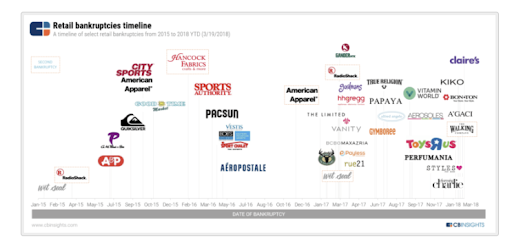
The reality is that modernizing legacy applications while taking into account the vast amounts of new data being generated, the myriad of data silos and disparate systems, transitioning to cloud computing, and constantly shifting consumer behaviors is an extremely difficult balancing act.
So what does it look like when this balancing act is successfully pulled off?
We’ll take a look after taking a brief trip into the future.
Ghost of Consumer Future
In some respects, the future is playing out for many brands that have largely shed legacy debt, thereby enabling them to invest the bleeding edge of technology.
There’s a convergence of technologies that—taken independently—are all impactful on their own. However, taken in sum, they’re highly complementary and will completely transform our world in the upcoming decade and beyond.
They are:
- AI/ML
- 5G
- IoT and edge/fog computing
- AR & VR
Think of each of these parts as oil paints on an artist’s palette. They can be used on their own in compelling ways to solve present-day business challenges. However, when combined together, they can address a mosaic of challenges that we have yet to even imagine.
And similar to the way that an artist’s colors have oils as the foundational component, data is the foundational component that underpins all of these future technologies.
Let’s take a quick look at each of the above technologies and how data plays a critical role in all of them:
- AI/ML - A successful AI/ML strategy is predicated on having access to vast amounts of data to train models. That data can come from numerous disparate systems across an enterprise. Once models are trained, they must be operationalized in an operational data layer to yield business outcomes.
- 5G - The headline feature of 5G is mobile speeds up to 10Gbps. However, often not covered is the significantly reduced latency (as low as 1ms) that will drive new real-time use cases. Faster speeds and lower latency will combine to strain application and data infrastructure like never before. Companies will have to modernize their data infrastructures to fully embrace the opportunities 5G will present.
- IoT and Edge/Fog computing - With 5G being deployed and an IoT boom underway, both velocity and volume of data will increase dramatically. So much so that it isn’t realistic for traditional relational databases to scale up. The only answer is to scale out at internet scale.
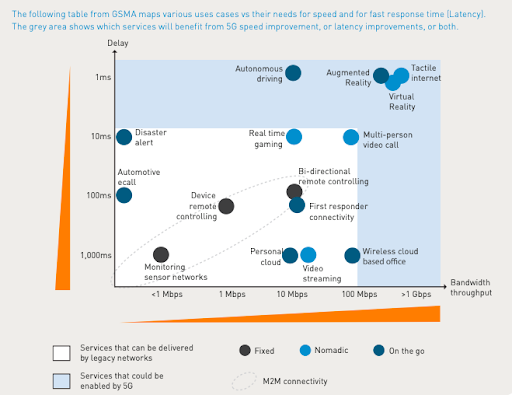
- AR/VR - Along with vastly improved hardware, again 5G will play a costarring role. AR/VR is highly dependent on both data velocity and throughput. If you’re a retailer leveraging augmented reality to place virtual furniture in a home, then it should be intelligent enough to seamlessly integrate C360, inventory data, and fulfillment data to offer a personalized and high-quality experience.




